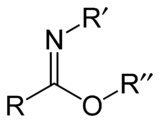Carboximidate

Carboximidates (or less specifically imidates) are organic compounds which can be thought of as esters formed between a carboximidic acid (R-C(=NR')OH) and an alcohol. They have the general formula R-C(=NR')OR".
Carboximidates are also known as imino ethers, since they can be thought of as imines (>C=N-) with an oxygen atom connected to the carbon atom.
Synthesis
Imidates may be generated by a number of synthetic routes,[1] but are in general formed by the Pinner reaction. This proceeds via the acid catalyzed attack of nitriles by alcohols.

Imidates produced in this manner are formed as their hydrochloride salts, which are sometimes referred to as Pinner salts. Carboximidates are also formed as intermediates in the Mumm rearrangement and the Overman rearrangement.
Imidate/amidate anions
Amidate anions, which are the equivalent resonance structure of imidate anions, can be thought of as the corresponding amide enolates, with the formula R-N=C(O−)R. Imidate/amidate anions find use as ligands.

Reactions
Carboximidates are good electrophiles and undergo a range of addition reactions; with aliphatic imidates generally reacting faster than aromatic imidates.[1] They can be hydrolyzed to give esters and by an analogous process react with amines (including ammonia) to form amidines. Aliphatic imidates react with an excess of alcohol under acid catalysis to form orthoesters RC(OR)3, aromatic imidates can also be converted but far less readily.

As a protecting group

Carboximidates can act as protecting group for alcohols.[3] For example, the base catalyzed reaction of benzyl alcohol upon trichloroacetonitrile yields a trichloroacetimidate. This species has orthogonal stability to acetate and TBS protections and may be cleaved by acid hydrolysis.[4]
See also
References
- 1 2 Roger, Robert; Neilson, Douglas G. (1961). "The Chemistry of Imidates.". Chemical Reviews. 61 (2): 179–211. doi:10.1021/cr60210a003.
- ↑ B. P. Mundy, M. G. Ellerd, F. G. Favaloro: Name Reactions and Reagents in organic Synthesis, 2. Auflage, Wiley-Interscience, Hoboken, NJ 2005, ISBN 978-0-471-22854-7, S. 516.
- ↑ Wuts, Peter G. M.; Greene, Theodora W. (2006). Protective groups in organic synthesis. (4th ed.). Hoboken, N.J.: WILEY. p. 244. ISBN 978-0-471-69754-1.
- ↑ Yu, Biao; Yu, Hai; Hui, Yongzheng; Han, Xiuwen (June 1999). "Trichloroacetimidate as an Efficient Protective Group for Alcohols". Synlett. 1999 (6): 753–755. doi:10.1055/s-1999-2736.